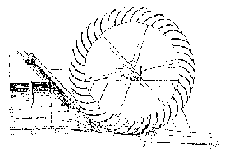Page 2
 There
was a lot of ingenuity involved. In order to provide their own water
supply, in 1913, the brothers built a water wheel 18 feet in diameter
(near where the townhouses on the water works road are now situated.)
A dam was built to ensure a constant supply of water for the wheel.
The brothers first built a test wheel to be sure the operation was feasible,
then built the wheel itself. They were required to lay 900 feet of pipe
from the wheel to the Hudson through swampy land. A water tower constructed
near the barn in 1914 ensured an adequate water supply and pressure
for the farm until 1935. It was decided in 1918 to harness the water
wheel to a dynamo to electrify the houses. Good idea, but it never supplied
enough power, so the properties hooked up with local utility for electricity
and gas.
There
was a lot of ingenuity involved. In order to provide their own water
supply, in 1913, the brothers built a water wheel 18 feet in diameter
(near where the townhouses on the water works road are now situated.)
A dam was built to ensure a constant supply of water for the wheel.
The brothers first built a test wheel to be sure the operation was feasible,
then built the wheel itself. They were required to lay 900 feet of pipe
from the wheel to the Hudson through swampy land. A water tower constructed
near the barn in 1914 ensured an adequate water supply and pressure
for the farm until 1935. It was decided in 1918 to harness the water
wheel to a dynamo to electrify the houses. Good idea, but it never supplied
enough power, so the properties hooked up with local utility for electricity
and gas.
There were several ponds on the property. The brothers hauled dirt into the field between St. Peter's and the Gate House in order to eliminate one of several ponds on the property. This was not entirely successful but adequate to use the field to grow vegetables. The problem was finally solved in the mid 1970's by blasting a drainage trench from the field to beyond Marian Hall.
Fed by natural springs,
another pond with a small island was located on what is now the site of the Lowell Thomas Building. In 1911 it was drained,
deepened, and rimmed by a hired mason. Around 1935, it was converted
into an outdoor swimming pool. To create a base for the concrete bottom,
the brothers pressed old bedsprings vertically into the mud, then added
a horizontal layer of bedsprings, and poured the base, mixing the elements
by hand.
is now the site of the Lowell Thomas Building. In 1911 it was drained,
deepened, and rimmed by a hired mason. Around 1935, it was converted
into an outdoor swimming pool. To create a base for the concrete bottom,
the brothers pressed old bedsprings vertically into the mud, then added
a horizontal layer of bedsprings, and poured the base, mixing the elements
by hand.
The cemetery was a hasty choice made when the first brother died in September 1909. It was placed in a hollow at the south end of the Bech property. Brother Peter Augustine spent one winter preparing the area and removing the stones. Brother Paul Acyndinus and the novices built the cement wall around the cemetery in 1921.
Home | Marist College | Library Home Page
last updated on June 10, 2004
